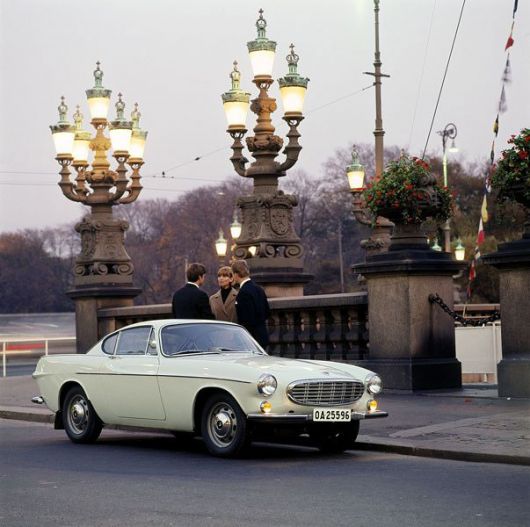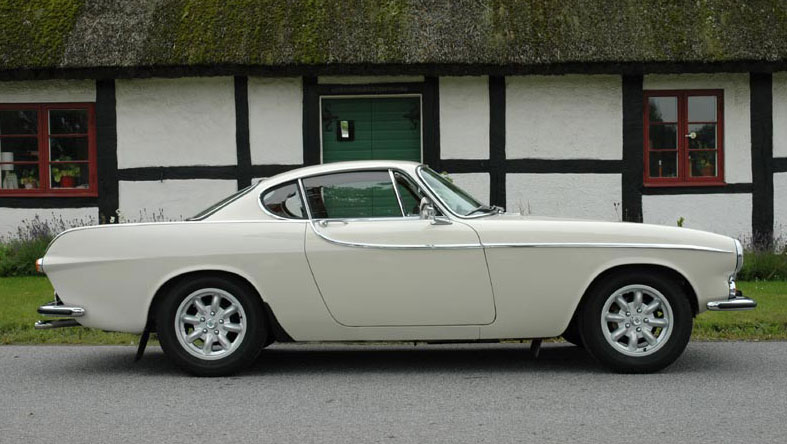1961 Volvo P1800

The man who really stressed that Volvo should make a new sports car was Helmer Pettersson, a consultant at Volvo. He had almost become idle after the shut down of the P1900. “Why don’t we make a real sports car”, he wondered.
The prototypes.
It is possible that Helmer Pettersson had his son Pelle in mind when he raised the proposal of building a new sports car. Mr Pettersson’s son had recently studied car design in USA. He was hired by Italian cahssis design studio Frua in 1957, an affiliated company to Ghia in Italy.
Frua got the task to make Volvo’s new sports car, because Ghia was prevented due to an agreement with Volkswagen. In July the same year five different designs were ready. Two from Ghia, two from Frua and one made by Pelle Pettersson. When Frua’s manager saw Pelle’s proposal he asked Pelle to remodel Frua’s proposals in order to make them more similar to his own, before the presentation to the Volvo management. Pelle did so, somewhat reluctantly, since he considered the other proposals inferior.
In August all the proposals were shown to Gunnar Engellau, who didn’t hesitate for a moment. He went straight for Pelle’s suggestion. “I want this one” he said. “We haven’t made that one”, Frua’s manager admitted, “that is design of Pelle!”. When Mr. Engellau heard this, he flew into a rage, since he thougt he’d been cheated by Helmer Pettersson. However he stood by his decision but it was Frua who was praised, not Pelle Pettersson. Three prototypes were made by Frua on Helmer Pettersson’s chassis. When Engellau in December 1957 saw the first prototype he was very pleased. He determined the new car should resemble the prototype as close as possible.
Who would build the P1800?
Helmer Pettersson contacted Karmann in West Germany asking them to manufacture the new sports car. But once again Volkswagen hampered Volvo’s plans and forbid Karmann to make the new Volvo.
During this time news had leaked to the press that Volvo was about to make a new sports car and Volvo had to confirm the circumstances. Raymond Eknor went to England after he had received the following instruction by Volvo’s vice executive president G. Andersson, “You must take into consideration that we must build the car in a country where I can play golf.”
Eknor visited the Bristol factories first and then Jensen who produced Austin-Healy bodies. Together with Jensen and Pressed Steel, Englands largest bodywork manufacturer, a production agreement of 10,000 P1800 was signed in December 1958.
The bodies were pressed at Linwood in Scotland, (an excellent place for golfers), and then transported to West Bromwich, where Jensen had built a new factory (at Jensen West Bromwich) with an assembly-line for the P1800.
The start of the production.
On the outside there were only small changes from the prototype cars to the items in production. The V- badge on the grille was withdrawn, and the hub caps were simplified. The separate front bumpers were replaced. The interior, with rippings around doors and the rear end and storage space under the hat rack, was imitated from the Italian prototype. The dashboard became somewhat simplified.
The engine was of course an very important part of the cars. The new five bearing B18 engine was introduced with the P1800. The engine was a new design even if it reminded a lot of the old Volvo four cylinder engines. The engine weighed only 143 kg thanks to the usage of aluminium in the oil and water pumps. In the B18B version, that was used in the P1800, the engine had a compression ratio of 9,5:1 and delivered 100 b.h.p. SAE at 5 500 rpm. The intake manifold had two 1 3/4 inch SU HS6-carburators.
The engine was linked by a Borg&Beck clutch to the Volvo M40 gearbox. An electrically operated overdrive, Laycock-de-Normanville, with gear ratio of 0,76:1 was available as an option.
The start of the production was delayed more than two years. Consequently it wasn’t until May of 1961 that the first P1800 left the factory. The first pictures of the car were released to the press in 1959 and the prototypes appeared at car show in both Brussels and New York in 1960.
Many buyers were annoyed by the long time of waiting. In the USA many buyers who had paid a deposit had to wait for one year until the car was delivered. At last, however, they got a quiet and comfortable GT with great road handling, enough power and attractive bodylines.
New problems.
The problems were not yet over. Disagreements about the quality of the car made Volvo to place members of its own staff stationary in the Jensen plant to supervise the assembly of the car.
The low quality of the assembly and lacquer work gave Volvo a bad reputation. When Volvos new car plant was ready in 1963, space was provided for the P1800 in the old Lundby plant. The agreement with Jensen was solved by compensation. When 6000 cars were built, the production was transferred to Gothenburg. The cars got the suffix “S” that stands for made in Sweden.
The first 2000 cars were built on the same basic procedure as in England. The large wheel caps were replaced by the Amazon hub caps, the front direction indicators got orange lenses and leather-faced upholstery for the seat cushions and back rests appeared.
Even the door panels were redesigned. The engine’s output increased to 108 b.h.p. SAE enhanced by a new camshaft, stiffer valve springs and increased compression (10,0:1). The car was available in white, red and dark grey paint.
Free advertising.
The P1800 got a lot of free advertising at first. The car served as pace car in the 24 hour race at Sebring in Florida 1963 and 1964.
But the best boost for the sales was certainly in the TV series “The Saint”, where Simon Templar chased criminals in his P1800. It was a mere chance that Roger Moore drove the P1800 in this series. It was in fact a Jaguar E-type that the TV company really wanted, but Jaguar couldn’t supply the car in time. (The TV company is said to have paid full retail price for the car).
In 1964 the letter “P” disappeared, but new front seats with excellent comfort, a new rear seat with a folding back and standard fitting of luggage belts were provided. In 1965 more extensive innovations were made e.g. a new aluminium alloy grilles, straight bumpers with rubber moulding, the wheels now displaying oval ventilation holes and new hub caps. Four different colours were available, white or dark grey with red upholstery and red or light blue with black upholstery.
Increased output and soft top.
In 1966 the power of the 1800S was increased to 115 b.h.p. SAE by introducing an exhaust manifold featuring, separate exhaust pipes and modified silencers. The roadholding qualities were improved by enforcement of rear suspension. Buyers could benefit from soft top versions of the car with conversions from firms such as Radford in the UK and Volvoville in the US.
1967 meant the end of the upward sweep of the trim along the body side, new door handles and closed circuit cooling system as well as closed crankcase ventilation. In the US a B18 tune-up kit was available. A modified cylinder head with compression 11,1:1, a new cam shaft and larger valves. The output was increased to 135 b.h.p SAE at 6 000 r.p.m. In 1968 the tree spoke steering wheel was introduced.. Rumours said that the 1800 was about to be out of production and replaced by a new car based on the 140-series.
New engine and fuel injection.
The greatest event in 1969 was the introduction of the B20B engine, with a bore of 88,9mm, a displacement of 1986 cc, a compression ratio 9,5:1 and an output of 118 b.h.p at 5800 r.p.m. Further changes were dual circuit brakes and a viscose cooling fan.
In August 1969 the new 1800E was introduced with the new B20E. The engine specifications included 130 b.h.p. SAE at 6000 r.p.m, compression ratio 10,5:1, a new camshaft, larger intake valves and a Bosch electronic fuel injection. The 1800E car was equipped with gearbox of the M410 type produced by ZF in West Germany and disc brakes all around. On the exterior there were changes to emphasize the mechanical improvements. New Composite wheels 5 x15 displayed centres of cast aluminum alloy, extractor vents mounted in the rear fins and the grille finished in matt black. On the inner side the driver was offered a revised dash with instruments in matt black rims. The instruments and control sections were covered with mock wood inserts and head restraints were standard. New colours were steel blue metallic and safari yellow.
The changes in 1971 were few. The manual gearbox M41 was back after reinforcing the second gear. The automatic transmission was available as an option to the four speed manual with overdrive. New colours were turquoise and gold metallic.
